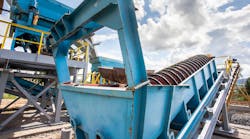Rapidly declining prices and improved performance of lithium-ion (Li-ion) batteries will likely create a key role for this technology in emerging markets over the next decade, from electric vehicle propulsion to grid-connected energy storage. However, increasing demand for Li-ion batteries is also raising concerns over the social and environmental impacts associated with the mining of materials used in their manufacture—specifically, cobalt, graphite, lithium, manganese, and nickel.
"Responsible sourcing is becoming a focal point for battery buyers, investors, regulators, and the advocacy community as demand for the product increases," say the authors of The Battery Revolution: Balancing Progress with Supply Chain Risks, a briefing paper published by supply chain audit consultancy RCS Global. "Yet the complexity and multiplicity of Li-ion battery supply chains make the process hugely challenging."
According to RCS Global, media and regulatory scrutiny are increasingly focusing on abuses relating to human rights, child labor, safety, and pollution in the battery supply chain. These issues present reputational, legal, compliance, and commercial risks for downstream industries, including consumer electronics manufacturing, that rely on lithium battery technology.
To date, electronics manufacturers' efforts to address social and environmental issues relating to mining of the aforementioned five battery materials have focused principally on cobalt. In 2014 Apple internally re-classified cobalt as a "conflict mineral," treating it in the same manner as tin, tantalum, tungsten, and gold ("3TG"), which are subject to conflict minerals legislation in the United States and the EU. In 2016 the Electronic Industry Citizenship Coalition launched the Responsible Raw Materials Initiative, flagging child labor risks related to cobalt mining in the Democratic Republic of the Congo as a priority concern.
And while cobalt "remains the primary risk," according to RCS Global, the group says that may simply reflect the fact that the metal's supply chain has been more thoroughly investigated than those of the other battery materials. Due diligence concerns loom across all five metals, according to the report's authors, who have developed a matrix mapping the extent of risk within each of the materials' supply chains.
- Graphite comprises much of the anode in most Li-ion batteries and acts as host for the lithium ions. In 2016, 66% of the world’s graphite came from China, with increasing production in Madagascar and new deposits under development in Mozambique, Namibia, and Tanzania. According to RCS Global, graphite supply chains include "certain" environmental damage around, and poor occupational health and safety in, industrial mines. Additionally, some graphite supply chains source from conflict-affected or high-risk countries.
- Lithium makes up 40% of the "traditional" Li-ion battery—the lithium cobalt oxide (LCO) variant used predominantly in mobile technologies. While Australia dominates production, Argentina, Bolivia, and Chile hold 54% of the world’s resources. Lithium is sourced from industrial mines, some of which inflict environmental damage on surrounding areas and others of which are reported to disregard human rights. Some supply chains source from conflict-affected or high-risk countries.
- Nickel constitutes a large proportion of the nickel manganese cobalt (NMC) batteries that are expected to become the standard for electric vehicles owing to their long-lasting charge. The Philippines currently produces 22% of the world's nickel supply, with Indonesia another important producer. The primary risk is environmental damage around industrial mines—specifically Illegal deforestation in the Philippines and water contamination in Indonesia.
- Over three-quarters of the world's manganese, also used in NMC batteries, is produced in only four countries: Australia, China, Gabon, and South Africa. Poor occupational health and safety in industrial mines is the chief concern, although environmental damage around industrial mines and human rights abuses at both industrial and artisanal mines have been reported.
In addition to these upstream risks, the authors note, the central role China plays as a midstream processor in Li-ion battery production has implications for downstream industry compliance. China is the world's largest global importer of cobalt, nickel, manganese, and lithium—as well as the world's leading global graphite producer. A lack of corporate transparency, poor working conditions and environmental standards, and governmental involvement in business contribute to responsible sourcing risks in the country's minerals processing sector.
Given the growing demand for Li-ion battery materials and their concentrated upstream supply, companies cannot achieve due diligence simply by reorienting their supply chains from high-risk producers or countries, the report cautions. Moreover, baseline compliance approaches increasingly fall shy of what the authors say is a "consensus forming" around adherence to OECD due diligence guidance for responsible sourcing of minerals from high-risk areas.
Auditing and supply chain mapping are essential for downstream companies looking to begin engaging in responsible sourcing, the authors contend. That means knowing what is sourced and where it is sourced from; establishing strong company due diligence management systems; and developing innovative solutions for traceability.
Beyond aligning with OECD guidance, companies may also wish to pursue what RCS Global refers to as a more "disruptive approach"—developing tailored programs aimed at setting industry best practices for reporting on and responding to risks in the battery supply chain. Properly executed, the report suggests, such an approach can deliver significant reputational gains and brand enhancement.










